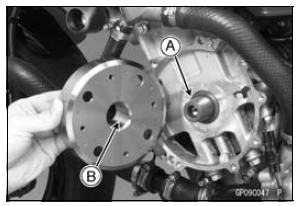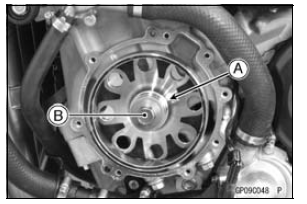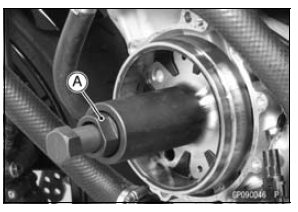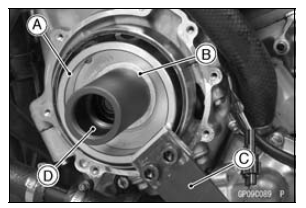

Crankshaft Tapered Portion [A] Alternator Rotor Tapered Portion [B]


NOTE
Confirm the alternator rotor fit or not to the crankshaft before tightening it with specified torque.
Special Tool - Flywheel Puller Assembly, M38 × 1.5/M35 × 1.5: 57001-1405

If the rotor is not pulled out with 20 N·m (2.0 kgf·m, 15 ft·lb) of drawing torque, it is installed correctly.
If the rotor is pulled out with under 20 N·m (2.0 kgf·m, 15 ft·lb) of drawing torque, clean off any oil dirt or flaw of the crankshaft and rotor tapered portion, and dry them with a clean cloth. Then, confirm that it is not pulled out with above torque.

Special Tools - Grip [C]: 57001-1591 Rotor Holder: 57001-1666 Flywheel Puller Assembly, M38 × 1.5/M35 × 1.5 [D]: 57001-1405 Rotor Holder Attachment: 57001-1689 Torque - Alternator Rotor Bolt: 155 N·m (15.8 kgf·m, 114 ft·lb)
 Alternator Rotor Removal
Alternator Rotor Removal Charging Voltage Inspection
Charging Voltage InspectionKIBS Hydraulic Unit Installation
NOTICE
Brake fluid quickly ruins painted plastic surfaces;
any spilled fluid should be completely washed away
immediately.
Install the KIBS hydraulic unit together with the bracket.
Before installing the brake pipe, check to see that there is
no damage on the threads of the brake pipe joi ...
US, CA and CAL Models
1. Hold the water hose [A]. Insert the tab into the slot.
2. Hold the water hose [B]. Insert the tab into the slot.
3. Water Hose Fitting on Cylinder Head
4. Heat Insulation Rubber Plate
5. Run the crankshaft sensor lead and the oil pressure switch lead into the
slot, and hook the slot
on ...
Cylinder Head Cover Removal
Remove:
Air Suction Valves (see Air Suction Valve Removal)
Throttle Body Assy (see Throttle Body Assy Removal in
the Fuel System (DFI) chapter)
Stick Coils (see Stick Coil Removal in the Electrical System
chapter)
Remove the clamps [A].
Turn up the front side of the heat insulation ...